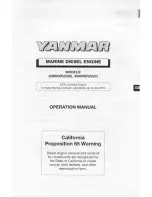
Installation, operation and maintenance instructions
High voltage flameproof motors for explosive atmosphere
AMD Rg 355-400-450-500
Medium voltage windings maintenance
Issued by: MOLM
Sheet No
3AAM101046 E
Rev. B
01.2023
Page 3 of 4
We r
es
erv
e
a
ll r
ight
s i
n t
his
doc
umen
t a
n
d i
n t
he
inf
or
mat
ion
cont
ain
ed
ther
ei
n. R
epr
o
duc
tion
,
us
e
of
dis
clo
su
re
to
th
ird
part
ies
w
itho
ut
ex
pr
es
s auth
ority
is
s
tr
ic
tly
f
or
bi
dden.
Spray-wash.
The spray-wash is usually carried out with a
conventional spray or with an airless high-
pressure spray.
The high-pressure spray is more effective in
removing dirt. If a detergent agent is used, it
should remove the dirt without softening or
damaging the insulation.
Dip wash.
The winding is completely immersed into the
detergent agent. Since with this method the dirt is
not removed mechanically, a very effective
cleaning and scouring agent is needed, and a long
dipping time may be required. Be sure that the
detergent does not soften or damage the
insulation.
Wiping.
Wiping is used when spray-wash is not possible.
The surfaces easily reached are wiped clean with
a cloth dampened with detergent. In cramped
areas of the winding, a special brush may be more
effective.
Water wash
The water wash is usually required after one of the
cleaning method described above, in order to
remove the detergent residues and prevent these
from penetrating into places where they cannot be
removed. After cleaning the winding is rinsed with
pure water several times. It is recommended to
use distilled water or deionized water for the last
rinse. Drying after the water wash is necessary.
Detergent agents.
Refer for further details to the Sheet
3AAM101045.
Before any detergent agent is used, its possible
damaging effect on the old winding surface should
be checked. A suitable test can be performed as
follows:
Using a piece of cloth wet with the detergent, rub
the surface to be tested for about five minutes.
Make sure that the surface remains completely
wet during this time. After rubbing, try to remove
the finishing varnish of the windings by the thumb
nail. Do the same thing on a dry part of the
surface, for comparison. If the surface layer is soft
or can be removed easily, the detergent agent is
too strong.
For minimal environmental loading, water should
be used, if the dirt is soluble in water. If the dirt
contains grease components, detergents that
improve the cleaning power can be added to the
water. Make sure that these detergents do not
leave electrically conductive residues on the
windings surfaces. Some detergents are soluble in
water, like acetone or isopropyl alcohol, and are
effective for this purpose. Remember that these
solvents are highly inflammable and must be used
with the proper precautions.
If organic solvents must be used as detergent
agents, only solvents based on aliphatic
hydrocarbons are recommended. Use detergent
agents halogen-free and without chlorinated
components.
White spirit is the most common organic solvent. It
is effective for grease, but unfortunately quite
inefficient for bitumen-like dirt that can be
produced on the windings by the burning residues
of fires.
Drying.
The windings must be dried after a wash or if they
have become humid in use or following a long
standstill.
A wet motor should be dismantled and the
winding possibly dried in the oven. In case the
motor is not very wet, the winding can be dried by
passing current through it by means of a low
voltage-high current device like a welding
generator.
Remark!
When electric current is used for drying the
winding, the rotor must be first removed from the
motor. DC or AC current can be used.
Current intensity cannot exceed 25% of the
rated current value
indicated on the nameplate of
the motor.
The rate of temperature rise during the heating
should not exceed 5°C (9°F) per hour, and the
final temperature should not exceed 105°C
(220°F). A sudden temperature rise or a final
temperature too high, can cause steam to be
formed in the cavities of the windings, which in
turn can damage the insulating barrier. During the
drying process the temperature should be
monitored periodically, and the insulation
resistance measured at regular intervals.
When drying in an oven, set the oven temperature
at 90°C (194°F) for 12 to 16 hours and then to
105°C (220°F) for further 6 or 8 hours.
Effective drying is achieved with proper balance of
heat and ventilation. The air inside the machine
should be circulated in the most effective way.
This is usually obtained using a ventilated oven. In
case the winding would be heated with current or
with hot-air blower, ensure an adequate fresh air
exchange along the winding.
The drying of the windings should be followed by
insulation resistance measurements. At the
beginning of the drying treatment the insulation
resistance value decreases due to temperature
rise. As the drying continues, however, the
















































